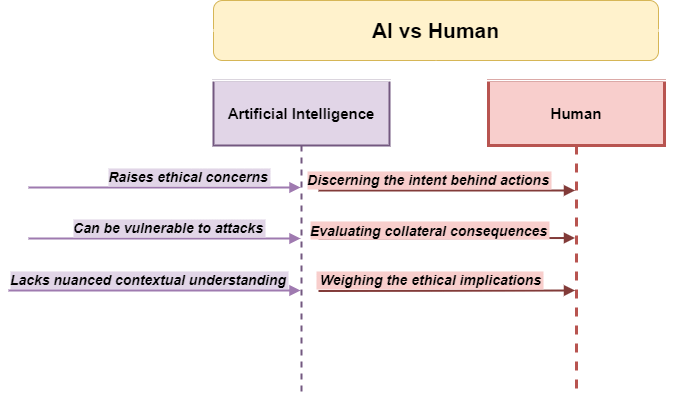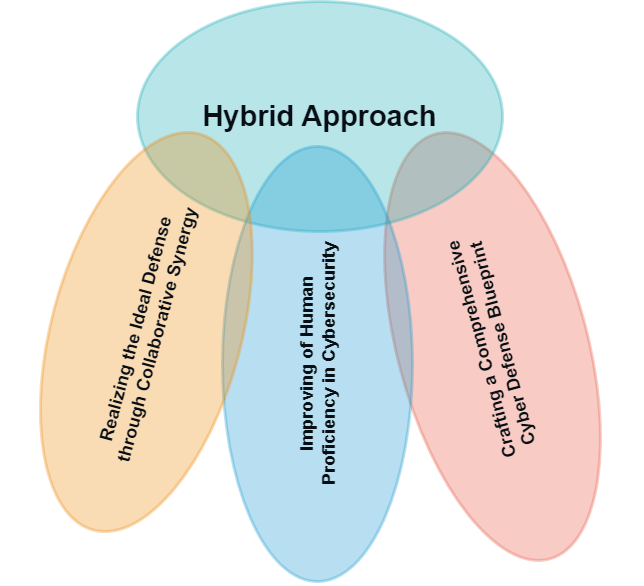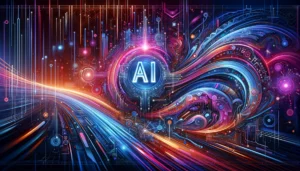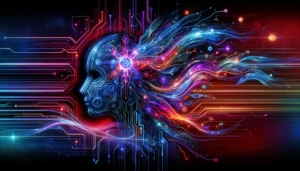AI in Cybersecurity Automation

Artificial intelligence is changing the cybersecurity sphere, offering sophisticated solutions that automate tasks, detect threats, and enhance Cyber Incident Response in unprecedented ways. This profound impact is transforming how cybersecurity professionals operate and how organizations combat cyber-attacks.
AI is improving cyber incident response by automating various tasks. AI-powered security solutions efficiently scan networks for vulnerabilities, detect suspicious activities, and block malicious traffic autonomously. This allows security experts to allocate their time to more intricate tasks like incident investigation and devising advanced security strategies.
Artificial intelligence significantly contributes to threat detection in cyber incident response. By analyzing vast datasets, AI-driven security solutions identify patterns and trends that signal potential attacks. This proactive approach enables security teams to anticipate threats and take preemptive measures to mitigate them before causing harm.
AI plays crucial role in enhancing incident response capabilities. AI-powered security systems provide real-time alerts and guidance to security professionals, enabling swift and effective responses to incidents. This rapid intervention minimizes the impact of attacks and mitigates potential damage swiftly. AI’s influence on cybersecurity professionals and incident response is profound. By automating tasks, detecting threats, and improving incident response, AI is changing cybersecurity practices, bolstering organizations’ defenses against cyber-attacks.
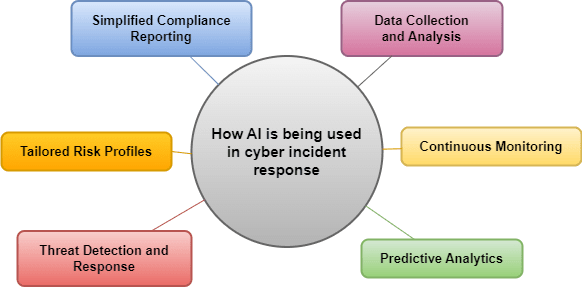
How AI is being used in cyber incident response
Automated risk assessments involve employing AI algorithms to systematically and efficiently evaluate and analyze different risks. These assessments minimize human intervention by relying on automated procedures to collect data, conduct analyses, and create risk reports. They find application in diverse fields such as security, finance, compliance, and others.
AI plays a transformative role in these automated risk assessments, significantly improving accuracy, efficiency, and the responsiveness of risk evaluation processes.
Data Collection and Analysis
Artificial Intelligence systems showcase remarkable capabilities in gathering, processing, and scrutinizing extensive data from varied sources. They continuously monitor network traffic, system logs, and user behaviors, swiftly detecting anomalies that might indicate security threats or non-compliance issues. This proactive approach empowers organizations to react promptly to emerging risks.
Predictive Analytics
AI-driven risk assessments harness machine learning algorithms to forecast future risks by examining historical data patterns. Through analysis of prior security incidents and compliance breaches, AI can discern trends and vulnerabilities, enabling proactive risk mitigation measures before they manifest.
Continuous Monitoring
AI-powered systems facilitate ongoing security and compliance monitoring, diminishing the necessity for periodic evaluations. This continual oversight ensures immediate identification and resolution of any deviations from established security protocols or compliance standards.
Tailored Risk Profiles
AI has the capability to craft personalized risk profiles for organizations, tailoring risk assessments to their unique needs and vulnerabilities. This personalized approach allows organizations to allocate resources efficiently to address critical areas of concern.
Simplified Compliance Reporting
AI streamlines the generation of compliance reports, simplifying the process of showcasing adherence to regulatory mandates. This automation not only saves time and effort but also minimizes the likelihood of human errors in reporting.
Threat Detection and Response
AI systems swiftly identify and respond to security threats in real-time, enabling rapid incident response. Automated threat detection and response mechanisms aid in mitigating the impact of breaches, minimizing operational downtime, and ensuring cybersecurity measures.
Limits of Artificial Intelligence in Cybersecurity
While Artificial Intelligence holds great promise for fortifying cybersecurity, it’s crucial to acknowledge that AI isn’t a cure-all. There are inherent limitations to what AI can accomplish within the intricate and ever-evolving realm of cyber threats.
AI excels in recognizing patterns and making automated decisions based on historical data. However, it often lacks the nuanced contextual understanding that humans possess. Discerning the intent behind actions, evaluating potential collateral consequences, or weighing the ethical implications of a response are areas where human insight and experience are irreplaceable.
Ironically, the very AI used to detect and prevent cyber threats is itself vulnerable to attacks. Adversarial attacks involve intentionally manipulating input data to misguide AI algorithms, leading to erroneous conclusions. This vulnerability emphasizes the necessity for human oversight and intervention to identify and counter such malevolent manipulations.
The integration of AI in cybersecurity prompts ethical concerns surrounding privacy, bias, and accountability in decision-making. Striking a balance between AI-driven automation and human supervision, ensuring unbiased algorithms, and comprehending the ethical implications of AI’s role in cybersecurity are critical dialogues that require human intervention and ethical frameworks.
While AI harbors vast potential to transform cybersecurity, grasping its limitations is vital. Human intelligence, with its ability for critical analysis, ethical considerations, and adaptability, remains essential in addressing AI’s constraints and ensuring a holistic and balanced approach to cyber defense. The most effective strategy involves harnessing the strengths of both AI and human intelligence in a synergistic partnership.
The Role of Human Intelligence in Cybersecurity
Amidst the changing sphere of cyber threats, human intelligence remains a cornerstone in fortifying organizational security. Despite technological advancements, human involvement stands as the foremost defense and critical analytical mind in protecting digital assets.
Extensive training and education form the bedrock of a cyber defense. It is important to inform all the staff about cyber hygiene, adeptness in recognizing phishing attempts, proficiency in secure data handling, and awareness of incident reporting protocols is crucial. Regular training empowers individuals to actively safeguard their organization’s digital domain.
Human intelligence brings an irreplaceable level of intuition and creativity that AI finds challenging to replicate. Identifying novel attack vectors, devising innovative security measures, and anticipating potential threats often necessitate human intuition. This capacity for creative thinking and rapid adaptation to emerging threats is a unique strength of human intelligence.
During cyber crises, human expertise becomes paramount. Effectively managing cyber incidents requires swift decision-making, crisis handling abilities, and adeptness in collaborative efforts under pressure. Human intelligence excels in contextual assessment, devising efficient strategies, and leading teams to mitigate the impact of cyber attacks and restore normal operations.
The human element remains an indispensable asset in cybersecurity, complementing the capabilities of AI. Despite technological advancements, the value of human intelligence remains constant and irreplaceable. Organizations should foster a culture that harnesses this unique human prowess, promoting collaboration and a shared responsibility toward cyber resilience. The effective integration of human vigilance and AI-powered tools is essential in building an impenetrable defense against cyber threats.
Hybrid Approach
Fusion of human capabilities with innovative technologies is the pathway to comprehensive defense. The convergence of human intuition, creativity, and adaptability with the computational power of Artificial Intelligence defines the future of cyber resilience.
Realizing the Ideal Defense through Collaborative Synergy
The future of cybersecurity hinges on the synergy between AI and human intelligence. AI systems excel at rapidly analyzing extensive data, spotting patterns, and detecting anomalies that might elude human detection. However, human intellect contributes a vital layer of contextual understanding, interpreting these findings within broader organizational and societal contexts.
Improving of Human Proficiency in Cybersecurity
Adopting AI as a tool to complement human analysts is a rising trend. AI’s ability to preprocess and analyze data provides valuable insights to human experts. This significantly enhances the efficiency and accuracy of human decision-making, enabling quicker and more precise responses to emerging threats.
Crafting a Comprehensive Cyber Defense Blueprint
A holistic cybersecurity strategy must adeptly utilize both AI and human intelligence. AI should handle tasks where rapid analysis and automation are crucial, such as sifting through vast datasets for potential threats. Conversely, human intelligence should focus on higher-level decision-making, strategy formulation, and ethical considerations in cybersecurity.
Balancing AI and human intelligence is the path ahead. By harnessing AI for its computational prowess and leveraging human intelligence for its analytical depth and adaptability, organizations can construct a robust defense against ever-evolving cyber threats. This hybrid approach is pivotal in keeping pace with the swiftly evolving threat landscape and staying ahead of cyber adversaries.





